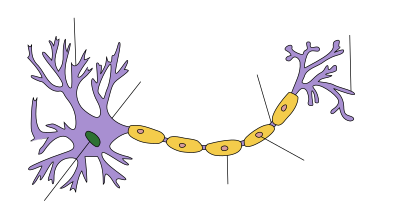Pathophysiology of multiple sclerosis
| Myelin sheath of a healthy neuron |
|---|
Multiple sclerosis is an inflammatory demyelinating disease of the CNS in which activated immune cells invade the central nervous system and cause inflammation, neurodegeneration and tissue damage. The underlying condition that produces this behaviour is currently unknown. Current research in neuropathology, neuroimmunology, neurobiology, and neuroimaging, together with clinical neurology provide support for the notion that MS is not a single disease but rather a spectrum
There are three clinical phenotypes: relapsing-remitting MS (RRMS), characterized by periods of neurological worsening following by remissions; secondary-progressive MS (SPMS), in which there is gradual progression of neurological dysfunction with fewer or no relapses; and primary-progressive MS (MS), in which there is neurological deterioration from onset.
Pathophysiology is a convergence of pathology with physiology. Pathology is the medical discipline that describes conditions typically observed during a disease state; whereas physiology is the biological discipline that describes processes or mechanisms operating within an organism. Referring to MS, the physiology refers to the different processes that lead to the development of the lesions and the pathology refers to the condition associated with the lesions.
Multiple sclerosis can be pathologically defined as the presence of distributed glial scars (or sclerosis) in the central nervous system disseminated in time (DIT) and space (DIS). The gold standard for MS diagnosis is pathological correlation, though given its limited availability, other diagnosis methods are normally used.
The scleroses that define the disease are the remainders of previous demyelinating lesions in the CNS white matter of a patient (encephalomyelitis) showing special characteristics, like for example confluent instead of perivenous demyelination.
There are two phases for how an unknown underlying condition may cause damage in MS: First some MRI-abnormal areas with hidden damage appear in the brain and spine (NAWM, NAGM, DAWM). Second, there are leaks in the blood–brain barrier where immune cells infiltrate causing the known demyelination and axon destruction. Some clusters of activated microglia, transection of axons and myelin degeneration is present before the BBB breaks down and the immune attack begins
...
Wikipedia

